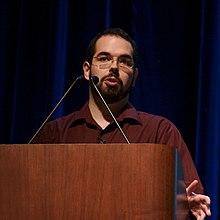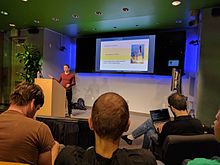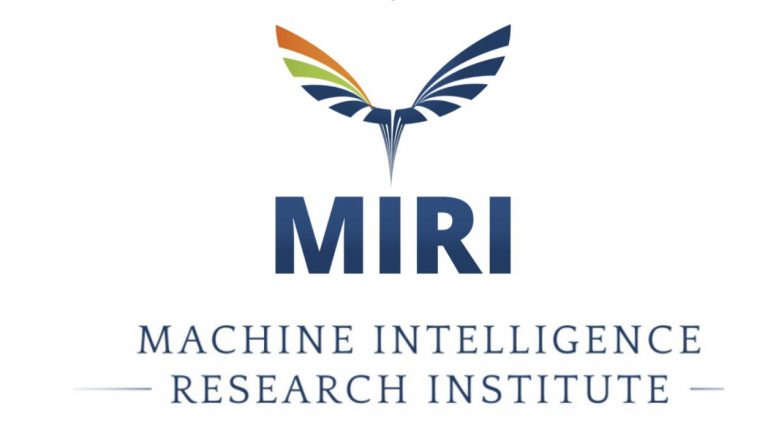Summary
The Machine Intelligence Research Institute (MIRI), formerly the Singularity Institute for Artificial Intelligence (SIAI), is a non-profit research institute focused since 2005 on identifying and managing potential existential risks from artificial general intelligence.
MIRI’s work has focused on a friendly AI approach to system design and on predicting the rate of technology development.
In 2000, Eliezer Yudkowsky founded the Singularity Institute for Artificial Intelligence with funding from Brian and Sabine Atkins, with the purpose of accelerating the development of artificial intelligence (AI). See onAir post.
Source: Wikipedia
OnAir Post: Machine Intelligence Research Institute (MIRI)
About
Overview
The Machine Intelligence Research Institute (MIRI) is a 501(c)(3) nonprofit based in Berkeley, California. We do research and public outreach intended to help prevent human extinction from the development of artificial superintelligence (ASI).
Source: Source: Website The stated goal of the world’s leading AI companies is to build AI that is general enough to do anything a human can do, from solving hard problems in theoretical physics to deftly navigating social environments. Recent machine learning progress seems to have brought this goal within reach. At this point, we would be uncomfortable ruling out the possibility that AI more capable than any human is achieved in the next year or two, and we would be moderately surprised if this outcome were still two decades away. The current view of MIRI’s research scientists is that if smarter-than-human AI is developed this decade, the result will be an unprecedented catastrophe. The CAIS Statement, which was widely endorsed by senior researchers in the field, states: Mitigating the risk of extinction from AI should be a global priority alongside other societal-scale risks such as pandemics and nuclear war. We believe that if researchers build superintelligent AI with anything like the field’s current technical understanding or methods, the expected outcome is human extinction. “Research labs around the world are currently building tech that is likely to cause human extinction” is a conclusion that should motivate a rapid policy response. The fast pace of AI, however, has caught governments and the voting public flat-footed. This document will aim to bring readers up to speed, and outline the kinds of policy steps that might be able to avert catastrophe. Source: arxiv AI evaluations are an important component of the AI governance toolkit, underlying current approaches to safety cases for preventing catastrophic risks. Our paper examines what these evaluations can and cannot tell us. Evaluations can establish lower bounds on AI capabilities and assess certain misuse risks given sufficient effort from evaluators. Unfortunately, evaluations face fundamental limitations that cannot be overcome within the current paradigm. These include an inability to establish upper bounds on capabilities, reliably forecast future model capabilities, or robustly assess risks from autonomous AI systems. This means that while evaluations are valuable tools, we should not rely on them as our main way of ensuring AI systems are safe. We conclude with recommendations for incremental improvements to frontier AI safety, while acknowledging these fundamental limitations remain unsolved. The Machine Intelligence Research Institute (MIRI), formerly the Singularity Institute for Artificial Intelligence (SIAI), is a non-profit research institute focused since 2005 on identifying and managing potential existential risks from artificial general intelligence. MIRI’s work has focused on a friendly AI approach to system design and on predicting the rate of technology development. In 2000, Eliezer Yudkowsky founded the Singularity Institute for Artificial Intelligence with funding from Brian and Sabine Atkins, with the purpose of accelerating the development of artificial intelligence (AI).[1][2][3] However, Yudkowsky began to be concerned that AI systems developed in the future could become superintelligent and pose risks to humanity,[1] and in 2005 the institute moved to Silicon Valley and began to focus on ways to identify and manage those risks, which were at the time largely ignored by scientists in the field.[2] Starting in 2006, the Institute organized the Singularity Summit to discuss the future of AI including its risks, initially in cooperation with Stanford University and with funding from Peter Thiel. The San Francisco Chronicle described the first conference as a “Bay Area coming-out party for the tech-inspired philosophy called transhumanism“.[4][5] In 2011, its offices were four apartments in downtown Berkeley.[6] In December 2012, the institute sold its name, web domain, and the Singularity Summit to Singularity University,[7] and in the following month took the name “Machine Intelligence Research Institute”.[8] In 2014 and 2015, public and scientific interest in the risks of AI grew, increasing donations to fund research at MIRI and similar organizations.[3][9]: 327 In 2019, Open Philanthropy recommended a general-support grant of approximately $2.1 million over two years to MIRI.[10] In April 2020, Open Philanthropy supplemented this with a $7.7M grant over two years.[11][12] In 2021, Vitalik Buterin donated several million dollars worth of Ethereum to MIRI.[13] MIRI’s approach to identifying and managing the risks of AI, led by Yudkowsky, primarily addresses how to design friendly AI, covering both the initial design of AI systems and the creation of mechanisms to ensure that evolving AI systems remain friendly.[3][14][15] MIRI researchers advocate early safety work as a precautionary measure.[16] However, MIRI researchers have expressed skepticism about the views of singularity advocates like Ray Kurzweil that superintelligence is “just around the corner”.[14] MIRI has funded forecasting work through an initiative called AI Impacts, which studies historical instances of discontinuous technological change, and has developed new measures of the relative computational power of humans and computer hardware.[17] MIRI aligns itself with the principles and objectives of the effective altruism movement.[18] Web Links
The Problem
AI Alignment
Research
What AI evaluations for preventing catastrophic risks can and cannot do
More Information
Wikipedia
Contents
History

Research and approach

Works by MIRI staff
See also
References
Further reading
External links
![]()



